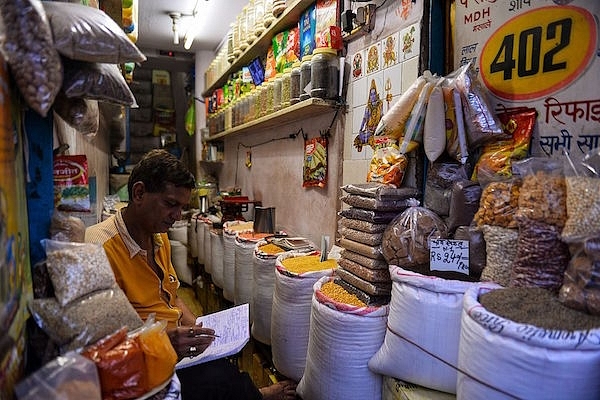Economy
GST Will Enable Real-Time Data: Is Govt Ready For This Big Data Revolution?
- The GST will be administered through an integrated IT network, the GST Network, under which companies will upload nearly three billion invoices every month.
- These invoices, if competently aggregated, can give the government corporate, sectoral, sales, price and other information instantly.
- Crucial to the proper use of this data will be govt’s ability to use big data analytics and timely sharing of information between tax department and ministries.

Image Credit: CHANDAN KHANNA/AFP/Getty Images
A beneficiary of the expected passing of the Goods & Services Tax (GST) Bill will be the government’s statistics department, thanks to the availability of real-time data on the current health of the economy. Reason: the GST will be administered through an integrated IT network called the GST Network, under which companies, big and small, will upload nearly three billion invoices every month. These invoices, if competently aggregated, can give you corporate, sectoral, sales, price and other information instantly, as long as you have the ability to capture them properly.
But crucial to the success of this network will be the ability of the government to use big data analytics, a skill currently missing at the topmost levels of governments, and timely sharing of information by the tax department with the Central Statistics Office and the policy-making arms of the finance and other ministries.
We have currently around seven to seven-and-a-half million value-added tax assessees at the state level. With new additions to GST taxpayers once implementation begins, the government could soon be privy to sales and other data from over 10 million businesses.
Add the data already available on direct tax payments, and the new ones to be made available from the Bharat Bill Payments System – an IT architecture being operationalised for bill payments by the Reserve Bank of India – and any government will effectively have real-time economic data 24x7.
Rural data may be harder to come by, thanks largely to the exclusion of large segments from the formal economy, but with the rise of JAM – the Jan Dhan, Aadhaar and Mobile money trio – even the rural economy will get steadily monetised. Not for nothing did Nandan Nilekani, former Chairman of Infosys and the Unique ID Authority of India, tell a Swarajya seminar last weekend in Bengaluru that India will move from data-poor to data-rich very quickly.
Consider the possibilities
With sales invoices being uploaded daily by the million, with proper industry tags, we can know price and sales trends across sectors. This is far better than trying to obtain data from the Registrar of Companies database, which has caused much grief in the estimation of GDP data. Price trends in major manufactured goods, from basic goods to intermediate and final goods, will be available real-time.
In other words, government will know trends in manufacturing and services output well before we get the Index of Industrial Production (which comes with a two-month lag) or the monthly PMI (purchasing managers’ index for goods and services). While we may still have to wait for the official indices to be updated through the normal method, you will get early-warnings and be prepared for nasty surprises.
The Central Statistics Office has been unable to create a producer price index, which is crucial to estimating real GDP (which is money GDP minus the GDP deflator, which estimates inflation based on consumer and wholesale prices). Wholesale prices skew the picture as the deflator should ideally use producer and consumer prices to deflate money GDP. With the availability of a lot of producer sales data, we should be able to generate a producer price index faster.
The bill payments system will tell us how utilities (power, telecom and so on) are faring right now, and what to expect in terms of growth or profits or losses in these sectors.
And then, of course, we have income and corporate tax data available quarterly. (They actually come monthly, but quarterly is better, as advance taxes are paid only once a quarter).
India’s advanced GST and payments IT infrastructure will enable the government to receive critical data in real-time, well before the official indices catch them.
This means the Ministry of Statistics, and government economists, must be able to use big data analytics and develop sophisticated algorithms to estimate sectoral and overall economy trends.
The Minister of Statistics needs a competent data-savvy boss. One wonders if Sadananda Gowda, recently shifted from Law to Statistics, is the right man for the job. The ministry has to be at the forefront of a data revolution that can aid policy-making; it is not the place to shunt politically important, but average, performers. At the very least, Gowda needs a technocrat babu who can make big data work.
Too much data and too little ability to use it is of no use to the Modi government.
Introducing ElectionsHQ + 50 Ground Reports Project
The 2024 elections might seem easy to guess, but there are some important questions that shouldn't be missed.
Do freebies still sway voters? Do people prioritise infrastructure when voting? How will Punjab vote?
The answers to these questions provide great insights into where we, as a country, are headed in the years to come.
Swarajya is starting a project with an aim to do 50 solid ground stories and a smart commentary service on WhatsApp, a one-of-a-kind. We'd love your support during this election season.
Click below to contribute.
Latest